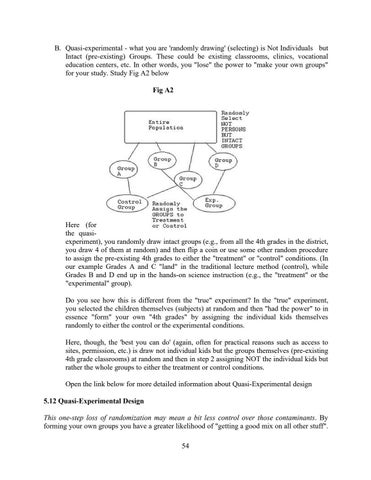B. Quasi-experimental - what you are 'randomly drawing' (selecting) is Not Individuals but Intact (pre-existing) Groups. These could be existing classrooms, clinics, vocational education centers, etc. In other words, you "lose" the power to "make your own groups" for your study. Study Fig A2 below Fig A2
Here (for the quasiexperiment), you randomly draw intact groups (e.g., from all the 4th grades in the district, you draw 4 of them at random) and then flip a coin or use some other random procedure to assign the pre-existing 4th grades to either the "treatment" or "control" conditions. (In our example Grades A and C "land" in the traditional lecture method (control), while Grades B and D end up in the hands-on science instruction (e.g., the "treatment" or the "experimental" group). Do you see how this is different from the "true" experiment? In the "true" experiment, you selected the children themselves (subjects) at random and then "had the power" to in essence "form" your own "4th grades" by assigning the individual kids themselves randomly to either the control or the experimental conditions. Here, though, the 'best you can do' (again, often for practical reasons such as access to sites, permission, etc.) is draw not individual kids but the groups themselves (pre-existing 4th grade classrooms) at random and then in step 2 assigning NOT the individual kids but rather the whole groups to either the treatment or control conditions. Open the link below for more detailed information about Quasi-Experimental design 5.12 Quasi-Experimental Design This one-step loss of randomization may mean a bit less control over those contaminants. By forming your own groups you have a greater likelihood of "getting a good mix on all other stuff". 54




